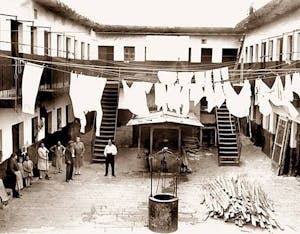Inmigration in Buenos Aires
Buenos Aires, one of the most European cities in South America. Why?
But, how is this possible? To understand this concept, we have to open a
window to the world of immigration.
When you visit Buenos Aires for the first time, one of the feelings you will get is
that of being in Paris, Rome or Barcelona. By 1870, Argentina had a population
of less than 2,000,000 people and Buenos Aires, less than 190,000 people. If
we consider that Argentina is the eighth largest country in the world, just a little
smaller than China, this point had to be considered, as the workforce available
was not enough for the growth of economy, related to agriculture since the
early years. For this reason, a law was enacted to encourage people to
emigrate to Argentina.
 Argentina was opening to the world and Europe had few opportunities. This was the perfect match for many foreign people to make Argentina their new home. That’s how thousands of Italians, Spaniards, Germans, and French, English and Welsh people, among others, decided to cross the ocean towards a land which was so unknown as promising. This way, by 1895, Buenos Aires had already multiplied its population by five. Without a doubt, grass was greener on this side.
Argentina was opening to the world and Europe had few opportunities. This was the perfect match for many foreign people to make Argentina their new home. That’s how thousands of Italians, Spaniards, Germans, and French, English and Welsh people, among others, decided to cross the ocean towards a land which was so unknown as promising. This way, by 1895, Buenos Aires had already multiplied its population by five. Without a doubt, grass was greener on this side.Even though most of the immigrants were European, many groups arrived from different places in Asia: Russia, Japan, Israel, Armenia, Turkey, Syria, just to mention some of them. After the I and II World Wars, we received new waves:
many Italian and Spanish groups decided to settle in Buenos Aires, while others
headed inland to different provinces in order to work in agriculture. Some
German communities established in Cordoba province; others, in Misiones
province. Many Welsh people settled in the present Chubut province and we
can still find their traditional architecture as well as the Welsh tea ceremony .
By 1980 and 1990, more immigrants arrived in our country. This time, they were
not coming from Europe. Argentina was the new home to people from Japan,
Korea, China, Senegal, Venezuela, Paraguay and Bolivia.  If you walk with attention to details, you will discover these influences. Furthermore, each of these groups left an important legacy to our culture and our everyday life. For this reason, we can find temples for each of the religions which coexist in this cultural melting pot. Very close to the Obelisk and the Columbus theatre
If you walk with attention to details, you will discover these influences. Furthermore, each of these groups left an important legacy to our culture and our everyday life. For this reason, we can find temples for each of the religions which coexist in this cultural melting pot. Very close to the Obelisk and the Columbus theatre
 If you walk with attention to details, you will discover these influences. Furthermore, each of these groups left an important legacy to our culture and our everyday life. For this reason, we can find temples for each of the religions which coexist in this cultural melting pot. Very close to the Obelisk and the Columbus theatre
If you walk with attention to details, you will discover these influences. Furthermore, each of these groups left an important legacy to our culture and our everyday life. For this reason, we can find temples for each of the religions which coexist in this cultural melting pot. Very close to the Obelisk and the Columbus theatre(Teatro Colón), we can find the first Synagogue built in Buenos Aires (also known as “Libertad Temple”). In Palermo, we will see the largest Mosque in Latin America. Besides religion, each community kept their cuisine: we can taste delicacies as pasta, gelato, pizza, paella, kosher dishes, ceviche, baba ganush, strudel, halal dishes, arepas, just to mention some of them.
 Walking around Buenos Aires means going back in time, being a little bit here and a little bit there; a place where everything lives together and merges to make it a unique city in the world. We invite you to discover it, while keeping in mind part of a poem by writer Jorge Luis Borges: For me, it is not true that Buenos Aires ever had a beginning, it is as eternal as water and air”.
Walking around Buenos Aires means going back in time, being a little bit here and a little bit there; a place where everything lives together and merges to make it a unique city in the world. We invite you to discover it, while keeping in mind part of a poem by writer Jorge Luis Borges: For me, it is not true that Buenos Aires ever had a beginning, it is as eternal as water and air”. T
